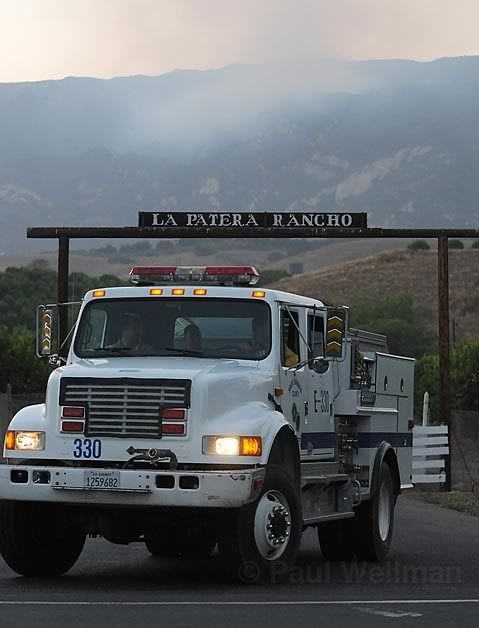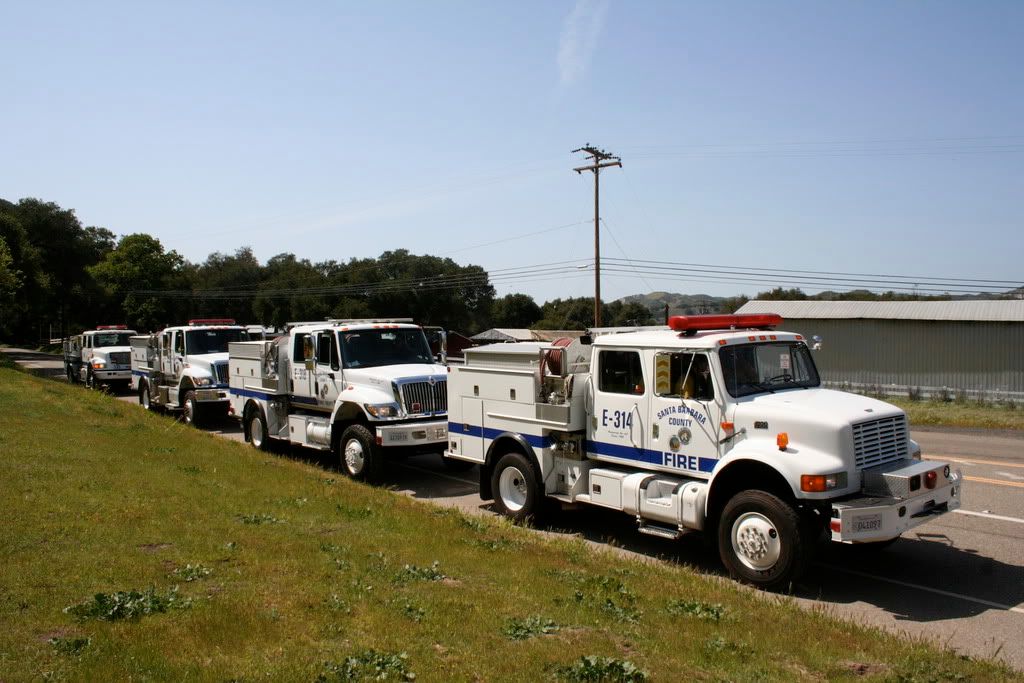New Wildland firefighting equiptment!
I am from a small vol. dept. and we have alot of wildland fires so I was wondering if any of yalls dept had any cool new stuff or Ideas for our new wildland truck we are putting together?
thanks
stay safe!!!!!!
thanks
stay safe!!!!!!
Tags:
Replies to This Discussion
-
Permalink Reply by aussie firery on October 8, 2008 at 6:42pm
-
yer im in vic im a vol with the cfa we carry gear such as qwick fill pumps,axes, maclowed tools, chain saws , foam , hose lol n lots of water lolz
-
Permalink Reply by Michael Harkey on October 8, 2008 at 7:05pm
-
I have recently put 2 new brush trucks in service, they both have bumper sprays which allows the driver to knock down some of the fire from inside the truck, they are mounted on each side of the ft. bumper. we also had a high pressure 1/2 lines with an adjustable wand it has 200' hose w/ electric rewind, it is good for getting into the brush when you don't need a large volume of water. I am attaching some photos
the builder is a local Oklahoma builder called Cooper Creek Mfg, you can google that to see their options. - Attachments:
-
-
 spray.jpg, 3 KB
spray.jpg, 3 KB -
 Caney, '08 rear.JPG, 1.6 MB
Caney, '08 rear.JPG, 1.6 MB -
 new trucks 016.jpg, 4.7 MB
new trucks 016.jpg, 4.7 MB
-
-
Permalink Reply by rfdjumper on October 8, 2008 at 8:04pm
-
How about pratical stuff instead of a rig that has unneeded bells and whstles, is overweight, and expensive, I've seen a department (mine) that spent 200,000 + on a brush truck when all they need is a pick up with a skid loader. Though the pump and roll bumper sprayers sound cool.
-
Permalink Reply by PFC Harmon on October 8, 2008 at 8:25pm
-
Are your wildland fires feild or forest? Good roads or jeep trails? We have a four wheeler with a trailer and 100 gal pump. 05 f550 4x4 dually 500 gal. 86 jeep cherokee no water 5 firefighters rakes flappers indian packs chainsaws and torches. The most important thing to have is forestry gear for all ffs full ppe and shelters.
-
Permalink Reply by Mike Schlags (Captain Busy) Retd on October 9, 2008 at 12:11am
-
you can't have enough power, you can't have powerful enough brakes and you need to put safeguards into the system to prevent accidents... and yes, there are equipment failures... put as much safety related items into your unit as possible.

In regard to brush truck concepts, I can't see getting anything other than a Type III for your brush truck of choice. You can go places that 4x4 pickups cannot, you can carry more water and hose, you have a bumper line to be used in conjunction with a top mounted hose reels to accommodate either a right or left flank attack. The trend now is to prepare yourself as a wildland urban interface engine, which means Type III.
I don't mean to be disrespectful to those firefighters who like the pickup with the pre-made tank and pump unit mounted in the rear bed but I have seen a lot of wildland fires in my career and would not want to have had to respond to them in a standard pickup truck 4x4. Access, visibility, ability to respond with four firefighters and each of us have our own SCBA, inside the cab. Area ignition, flashovers, blinding smoke... sometimes you have to ride it out and I've done it in a Type III, just the additional height alone makes it worthwhile due to radiant heat given off by ground level vegetation. We have a filtering system to prevent smoke from getting inside the cab.
My department is considered the first department in the United States to deal with and fight wildland fires. Ranchers in the 1920's formed a range protection group to deal with wildland fires intentionally set by the local band of the Chumash indians. At stake were valuable grazing lands for cattle. In 1926, my department was formed and started out with pickup trucks with skid mounts. The early ones employed a pump mounted on the front bumper that took it's power from the engine. We have learned a lot in the last 80 years and have learned unfortunately through tragedies.
In addition to a Type III, you have to adopt the strategy and tactics of the "progressive hose lay" concept. This was designed by west coast fire departments to effectively deal with wildland fires. If this is a new concept you you, please let me know and I will explain it. Key points include bump and roll tactics for wui fires (wildland urban interface). The meat and potatoes is always remembering to anchor and flank the fire, securing a starting point and moving along the flank. Special hose packs are pre-assembled and made to work as a backpack. Firefighters can both wear the pack, using the hose as the two shoulder straps for carrying. Pretty cool concept and it works... and works well.
A key point that has not been identified here is that you have not defined your problem. You may not need a Type III if you live in Wisconsin where you would actually have what we seldom see... rain. If parched arid climates is part of you first in then you need to kick it up a notch. We never know what we are going to respond to. With the California Mutual Aid System, you can find yourself anywhere in the state. We seem to have a lot of wildfires lately... and we learn from each and every one of them. This is what I am sharing with you my friend.
TCSS, Mike from Santa Barbara

Early Model Santa Barbara County Fire Department Type III Heavy Brush Engine
-
Permalink Reply by Mike Schlags (Captain Busy) Retd on October 9, 2008 at 12:39am
-

This is one of our newer Type III's.

This is a strike team of our Type III's.

Standard CalFire Type III Engine. Note the two rear hooks and hose line drapped for quick attack and egress, using pump and roll tactics. A hotshot crew is seen this picture working together with the Type III.
-
Permalink Reply by Trainer on October 9, 2008 at 7:09am
-
I'll have to agree with Mike here. We currently are specing somewhat of a wildland truck, multi use, class A pumper. I can't see wasting space in the station with a P/U. IH 4x4, 1000gal pump, 600gal water, top mount w/walk way, pump and roll,front bumper remote turret gun, 30gal foam. 29ft overall length, loaded w/equipment 31,000lbs. We just don't want to give up the class A, for ISO reasons. Now some of you are going to say it's to big, and will stick easy, but as in most cases it's not what you drive but how you drive. Around here it's mostly grass and cornfeild fires. We debated on the 4 door, but the extra 10 grand and the fact that our SOG is to roll our rescue w/manpower on all calls, we droped it. Total cost loaded with new everything,$306,000.
-
Permalink Reply by PFC Harmon on October 9, 2008 at 7:56pm
-
I agree with it depends on the terrain. In the great moutains of tennessee those trucks would be great for fires close to the road. We use our jeep more than anything most of our fires are of the forest fire type and are only accsesabale by pipeline roads or other muddy tiny trails.
-
Permalink Reply by Mike Schlags (Captain Busy) Retd on October 10, 2008 at 2:56am
-
do you use progressive hose lays for wildland fires?
-
Permalink Reply by Mike Schlags (Captain Busy) Retd on October 10, 2008 at 2:56am
-
you also get rain... we don't
-
Permalink Reply by Mike Schlags (Captain Busy) Retd on October 10, 2008 at 3:00am
-
we also have tons of sand... the trick with sand is to have a compressor fitting so you can refill the tires after you let them out to be able to drive over the sand. also, we have a built in foam system which makes foam delivery amazing using the MADD DOG foam nozzle. we have everything from sand, my first in includes over 50 miles of coast looking out at the Pacific Ocean... we also have tons of ag land on the other side of the mountains as well as the wildland urban interface issues... carrying a lot of water, foam and manpower is important for us but yes, geography does dictate what you need for response... ms
-
Permalink Reply by Trainer on October 10, 2008 at 7:09am
-
Tiny trials would be a problem, but as for a muddin or sand, high floatation tires on the front, supersingles on the back, now you'll need some horsepower to. Weight + traction + horsepower=it'll go anywhere a fullsize P/U will go, and with enough water to make a difference. Now throw in a polaris ranger with a pump and some water, ought to cover anything.
Specialty Websites
Find Members Fast
Firefighting Videos
© 2025 Created by Firefighter Nation WebChief.
Powered by
![]()
Badges | Contact Firefighter Nation | Privacy Policy | Terms of Service